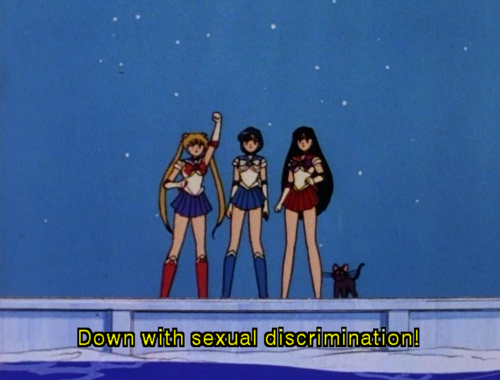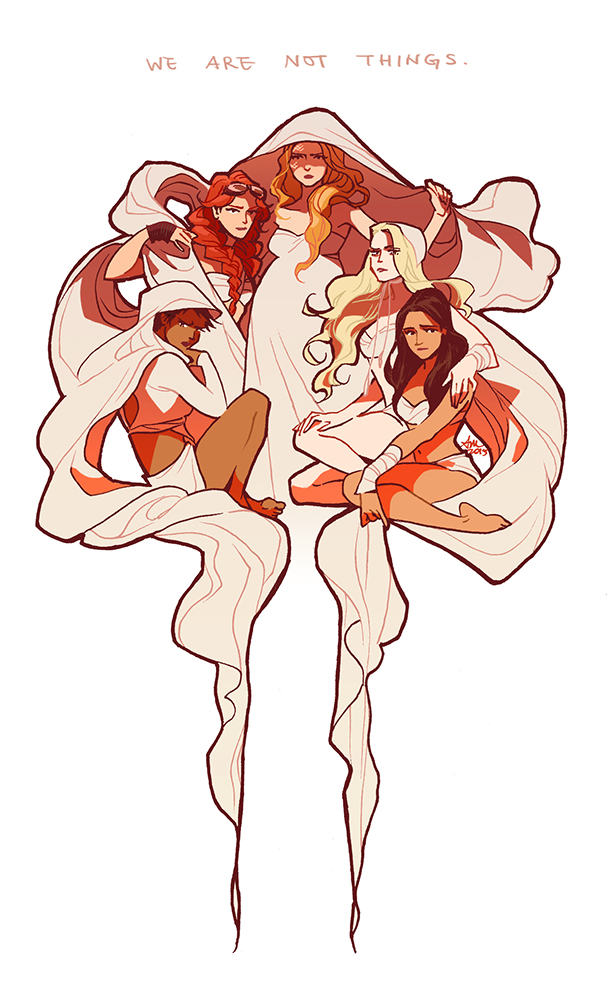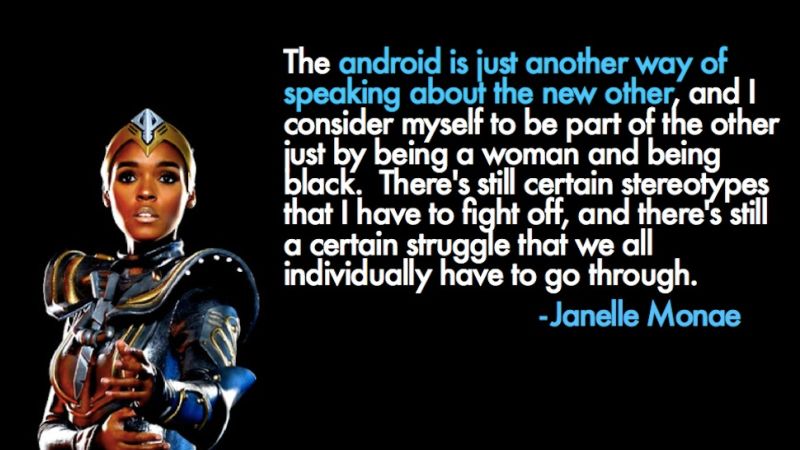For several years, TGA founder Marie-Pierre has been conducting research on the fraudulent phenomenon of “fake geek girls,” a category of women who ostensibly “pretend” to be geeky or interested in geeky things for male attention. This supposition that the geek identity is predominantly male and that geeky space must subsequently be policed for inauthentic intruders came to a head during the 2014 Gamergate controversy, in which certain groups of men not only felt that women participating in the gaming industry were somehow less committed or faking it, but also believed that feminist oriented criticism would destroy the industry and undermine creativity. While the bias that drove Gamergate may seem to be fairly niche, many of the sexist ideologies spill over into the broader entertainment industry, sphere of pop culture, and conception of “strong female characters.” The same logic of “fake geek girls” is applied to movies and television shows to justify a predominantly androcentric popular canon in science fiction and fantasy. Yet in reflecting on 2015, we witnessed what may be considered a paradigm shift in geek culture as fans pushed back against sexist attitudes and business practices for more honest, equitable and respectful representations of gender.
Emails leaked during the Sony hack demonstrated how deeply biased and flawed the market logic has been in exculpating producers, directors and writers for erasing female heroes from the Marvel roster. Citing such movies as Catwoman (2004) and Elektra (2005), Sony executives used the films’ subsequent flops in the box office to justify avoiding making any more female led movies, rather than citing the obvious fact that the films were poorly written, poorly produced and poorly executed, let alone reliant on the sexualization of what should have been complex female characters. As Bailey (2015) so cannily noted, any time a movie with a female protagonist doesn’t do well in the box office, gender is to blame. The same argument, however, is not applied to such equally bad films as The Spirit (2008), Green Lantern (2011), The Green Hornet (2011) or The Fantastic Four (2015) to name a few. Key female characters were also eliminated from screen adaptations this year, such as The Wasp from Marvel’s Ant Man (2015), while the female heroines who did make the cut were occluded in marketing and promotional materials, as well as toys and other consumer products. Sony’s contention that female representation simply isn’t good for business tacitly reiterates the belief that women aren’t an important part of their geeky fan base, while reinscribing the idea that male consumers are only interested in heroes of the same gender and background. This is insulting not only to the female contingent of the geeky community, but also assumes that every other fan shares the same discriminatory convictions.
Perhaps the most fractious demonstration of this perduring prejudice can be seen in the Avenger’s Black Widow. After the release of Avenger’s 2: Age of Ultron (2015), members of the Avenger’s cast joked that Natasha Romanoff is a slut and a whore for being potentially connected with so many romantic partners. It is assumed that Black Widow’s male counterparts are hardly to blame, nor is the same insult ever lobbed at the philandering Tony Stark; the promiscuity of male heroes has been the source of humor, if not respect, throughout cinematic history. In an intimate discussion with potential beau Bruce Banner, Romanoff also reveals that her initiation as a spy rendered her infertile. She refers to herself as a monster because she cannot reproduce. As if a woman’s worth should still be connected to her ability to bear children and Natasha’s inability to do so makes her not only abnormal, but somehow monstrous. The sentiment is undoubtedly essentialist and panders to the worst stereotypes of femininity, especially since Romanoff is one of the only female heroes in the movie. As has been reiterated in much greater detail and depth elsewhere, when you only have one individual from a minority population in a creative project, the character inevitably becomes a stand-in representative of that whole population, flattening personality, perpetuating stereotypes and precluding any kind of verisimilitude. Jurassic World (2015) is just as guilty of conflating a woman’s worth with her maternal instinct. Bryce Dallas Howard’s character, Claire, is continuously questioned by her family and co-workers for her decision to forgo having children. Even the ending of Mockingjay: Part Two (2015) felt flat to me. The redemption that Peeta and Katniss are offered is enacted through the heterosexual nuclear family. In the final scene of the movie, Katniss holds a new baby, playing the role of mother in a fresh, clean dress. Why is this the only resolution to violence or path to happiness we can imagine for such a courageous, yet clearly damaged heroine?
But in 2015, fans began to mobilize and organize in new and creative ways in order to stand up against decisions that continued to exclude women or permit problematic representations of gender. The #WeWantWidow flashmob was held in New York in June 2015 to advocate for better representation of Black Widow in both the Marvel movies and merchandise. While the movement may be partially premised on consumerism, businesses also depend upon the buying power of the public. So fans are beginning to protest with their wallets, using a language the market will understand and is forced to respond to. This year has also demonstrated that female led movies can not only succeed in the box office, but they can also break records and appeal to many different groups and populations. Mad Max’s Imperator Furiosa, Supergirl, Arrow’s Black Canary, Agent Carter, Jessica Jones and Katniss Everdeen ruled late night and the silver screen, each representing very different dimensions of what it means to be a woman, as well as what it means to be human. In the comic book industry as well, the stories of female heroes and leaders were both creatively supported and lucrative, further proving the saliency of diversity and the financial success of equal gender representation. Ms. Marvel and Thor were mainstays, accompanied by Spider Gwen, Nimona, The Rat Queens, The Lumberjanes and Bitch Planet. These successes have also mean increased opportunities for women and people of color to pursue creative and executive decisions, furthering the cause for equality in employment.
The use of violence against women as a plot device has also been summarily critiqued and acknowledged as creatively impotent, if not dangerous with reference to the increasing awareness about campus sexual assault against both men and women. The gratuitous rape scene of Sansa in Game of Thrones was met with ire by critics and the public; the show’s producers responded by promising less unnecessary sexual violence in the upcoming season. Other shows and movies have handled the issue of rape much more delicately. While it is assumed that Immortan Joe raped his Wives—Capable, Toast the Knowing, Splendid, Dag and Cheedo the Fragile—we are never forced to witness such an act of violation. The characterization of Joe is heinous enough without a surfeit of sexual violence and the audience implicitly believes the Wives. No one questions the ordeal they went through or asks them to explain what happened, unlike our criminal justice system. Netflix’s Jessica Jones does not equivocate about the lack of consent endemic to her relationship with Kilgrave. Her story explores the trauma of sexual violence and the complicated emotional and physical manipulation wrapped up in domestic violence. Using rape to add shock value or grittiness to a show is no longer so lightly tolerated; writers and directors are increasingly looking toward the damage incurred by such a blasé treatment of sexual violence upon women’s bodies and psyches.
And then there’s Star Wars. Before The Force Awakens was released, I was anxious about the role gender would play in the reboot. Whereas Princess Amidala was a capable, self-possessed leader in Episode I, her character quickly collapsed into the long suffering girlfriend and then wife of Anakin Skywalker in Episodes II and III. Lucasfilm also does not have the best track record when it comes to the original trilogy either—see Slave Leia in Return of the Jedi and the general lack of other female characters despite a galaxy populated by a multitude of alien life forms. The Force Awakens, on the other hand, was almost immediately heralded as a feminist triumph. While I am glad that the concept of feminism is being used more widely, I also worry that its theoretical ideas and political underpinnings are being ignored in the process, that by distilling the concept for more popular application the central discourses, arguments and tensions aren’t being considered. After Mad Max: Fury Road hit theaters this past summer, people debated whether it was feminist or not, as if the concept of feminism exists within a rigid, strictly controlled binary in which there is always a clear yes or no answer. These debates have also failed to contend with the multiple forms and versions of feminisms that should be taken into account. Creative projects can have feminist elements or undertones informing the product, but, just as there are shades of grey between the dark and the light side of the force, feminism is defined and qualified differently by different people and it’s not necessarily useful to think of these critiques along such dualistic lines.
I enjoyed The Force Awakens not simply because the protagonist, Rey, was a strong, capable, indomitable woman, but also because every character in the cast felt supremely human. Rey misses her family but has also found a way to survive in the deserts of Jakku for years. When she is sad or scared, she cries, revealing a vulnerability that is rarely afforded to “strong female characters.” She is not sexualized and her expertise at flying and mechanics is never questioned. These all may seem like simple, inconsequential things, but they are elements of characterization that are standard for men yet rarely afforded to women. Rey is still a cisgender white woman, but there are opportunities for intersectionality in the movie, particularly when it comes to the diversity of the supporting cast. The film also proves that an African America lead can succeed in a fantasy or science fiction universe, a space that has also been historically white. While the fake geek girl phenomenon may focus specifically on white, cisgender, heterosexual females, other groups are also discriminated against in the geek community. Whitewashing characters of color has become a common practice when adapting television or comic books, and roles for people are color are still limited. Same sex marriage is finally legal in the United States and our country has begun to conscientiously engage with issues such as sexual and gender identity. Queerness has found safe spaces within animation in a way that is truly unprecedented.
The crux of the fake geek girl phenomenon lies in questioning the truth and validity of another person’s experience, undermining or disbelieving their truth or identity. Not only has this been a year in which these biases and prejudices have been identified and called out, but people are mobilizing politically to show why representation matters. The entertainment industry has begun to respond by opening up new spaces for representation and involvement. My hope is that this political solidarity takes an intersectional turn by acknowledging the fact that violence—whether symbolic, structural or physical—is interconnected and that we cannot achieve true equality until the dimensions of identity in addition to gender are taken into account. Let’s hope that 2016 brings more progress and pop culture we can be proud of.
Works Cited
Anders, Charlie Jane (2015). “Please Stop Spreading This Nonsense that Rey from Star Wars is a ‘Mary Sue.’” io9. http://io9.gizmodo.com/please-stop-spreading-this-nonsense-that-rey-from-star-1749134275
Backe, Emma Louise (2012). “Violence and Victimization: Misogyny in Geek Culture (And Everywhere Else.” The Geek Anthropologist. https://thegeekanthropologist.com/2014/09/09/violence-and-victimization-misogyny-in-geek-culture-and-everywhere-else/
Backe, Emma Louise (2015). “Heroes Need to Woman Up.” The Geek Anthropologist. https://thegeekanthropologist.com/2015/03/02/the-weekly-geekout-heroes-need-to-woman-up/
Bailey, Jason (2015). “Leaked Sony Email Confirms Marvel’s Just as Clueless About ‘Female Movies’ As You Thought.” Flavorwire. http://flavorwire.com/517363/leaked-sony-email-confirms-marvels-just-as-clueless-about-female-movies-as-you-thought
Brand, Rebecca (2013). “’If she can’t see it, she can’t be it’: why media representation matters.” The Guardian. http://www.theguardian.com/women-in-leadership/2013/nov/12/media-representation-matters
Garber, Megan (2015). “Star Wars: The Feminism Awakens.” The Atlantic. http://www.theatlantic.com/entertainment/archive/2015/12/star-wars-the-feminism-awakens/420843/
March, Anna (2015). “Dead girls, killer ratings: ‘Game of Thrones,’ ‘True Detective,’ and TV’s epidemic of violence against women.” Salon. http://www.salon.com/2015/04/14/dead_women_killer_ratings_game_of_thrones_true_detective_and_tvs_epidemic_of_violence_against_women_partner/
Mey (2015). “’Stephen Universe’ And the Importance of All-Ages Queer Representation.” Autostraddle. http://www.autostraddle.com/steven-universe-and-the-importance-of-all-ages-queer-representation-281482/
Okundaye, Osahon (2015). “Why I Can’t Watch ‘Game of Thrones.’” The Huffington Post. http://www.huffingtonpost.com/osahon-okundaye/why-i-cant-watch-game-of-thrones_b_5120281.html
Pantozzi, Jill (2015). “We Will No Longer Be Promoting HBO’s Game of Thrones.” The Mary Sue. http://www.themarysue.com/we-will-no-longer-be-promoting-hbos-game-of-thrones/
Robinson, Tasha (2014). “We’re Losing All Our Strong Female Characters to ‘Trinity Syndrome.’” The Dissolve. https://thedissolve.com/features/exposition/618-were-losing-all-our-strong-female-characters-to-tr/
Renaud, Marie-Pierre. “The (Fake) Geek Girl Debate.” The Geek Anthropologist. https://thegeekanthropologist.com/category/gender/fake-geek-girls-geek-girls/
Shaw, Adrienne (2015). “Representation Matters: Reframing Arguments for Diversity in Digital Games.” Mellon Research Initiatives in Digital Cultures. http://digitalcultures.ucdavis.edu/2015/09/21/oct-7th-representation-matters/
Yang, Stephanie (2015). “Marvel Show ‘Jessica Jones’ Names a Most Evil Villain: Abuse.” Bitch Media. https://bitchmedia.org/article/marvel-show-jessica-jones-names-most-evil-villain-abuse









[…] In 2015, mainstream geek culture began to emerge as more than simply a popular and bankable enterprise–throughout the year, creative projects in the genre provided models of diversity and cultivated conversations about representation, responsibility, and intentionality. 2016, for all its flaws and foibles, continued to resist simple characterization. The television shows, movies, graphic novels, video games and journalism over the past year have provided thoughtful analysis and critiques of conditions of injustice, discrimination and insensitivity packaged into speculative and dystopian worlds that seem just familiar enough to verge into the uncanny. Despite the whitewashing of Doctor Strange and Ghost in the Shell, Luke Cage finally got his own standalone show on Netflix, in preparation for The Defenders (2017). Agent Carter was not renewed for a third season but some of our favorite comedians got to bust some ghosts and slip in commentary about the culture of online harassment against women. Some of us may never be able to hear “hold the door” again without ugly crying, but it was perhaps more gratifying to see Sansa Stark evolve from a simpering would-be lady to a cunning strategize intolerant of men’s egos or wanton sexuality. Other HBO shows like Westworld seem to finally be recognizing that sexual violence is a lazy, if morally bankrupt, plot device. […]
LikeLike
I respect your work.
LikeLike
[…] and Worldbuilding in The Force Awakens. Finally, check out Emma Backe’s 2015 in Review: Geek Girls and Gender in which she explores representations of women in pop culture using, among others, the example of […]
LikeLike
[…] to better understand contemporary ideologies, biases and belief systems, in addition to providing a platform for more diverse representation and social justice issues. There are political dimensions to popular culture that need to be […]
LikeLike
[…] its place in a stand alone category like Best Picture is up for debate. But The Force Awakens has done a lot for diversity and representation, particularly in a genre that has traditionally been marked by […]
LikeLike
Reblogged this on Emma Louise Backe.
LikeLike
Well done! Enjoyed every word and made me want to read more
LikeLike